| Author | Message | ||
| Roger Baughman (Roger)
Registered Member Username: Roger Post Number: 130 Registered: 11-2006 Posted From: 69.232.69.224 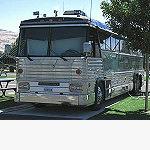 Rating: N/A |
I am going to install a set of 4 batteries as a back up for the power through my 4000 watt inverter to run my two roof air conditioners. I am installing the batteries in the old air conditioner condenser compartment on my 84 MCI 40FT. This conpartment is just in front of the foward bay on the drivers side. I am also going to install a back up 24 volt alternator powered by the 8v71. I going to but the alternator where the air compressor was. My question is, what size battery cable do I use to go about 36 feet between the batteries and the alternator. Thanks for any info on this that I get. | ||
| Nellie Wilson (Vivianellie)
Registered Member Username: Vivianellie Post Number: 303 Registered: 11-2008 Posted From: 75.178.92.43  Rating: N/A |
Roger - I can't answer your question, but I know a guy who can. I'll run it by him... he should be reachable by Tuesday. I assume we're talking a 24V load (from Alt. to Batteries?) I'm really curious about your "I going to but the alternator where the air compressor was" statement. So you removed your compressor? What are you doing for air? Reason I ask, I've been thinking about a backup air source. Maybe you've hit on a better idea? Nellie Wilson | ||
| FAST FRED (Fast_fred)
Registered Member Username: Fast_fred Post Number: 966 Registered: 10-2006 Posted From: 76.202.165.190 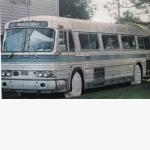 Rating: N/A |
Size counts , for such a long run really heavy cabeling will be needed. Even if 24V it may require 04 to reduce the voltage drop of such a huge run. The cost of heavy cables is so high $3.00 to $5.00 pr foot , both ways ,. On our Sportscar there were two 80A blowers to push air thru the coach. Could there be similar wiring in place on an MCI that could be reused to charge the house set? Sure would save big bucks if they were re-useable. You might wish to consider using a terminal AT the house bank to control the V reg , to assure a proper battery charge while underway. FF (Message edited by FAST FRED on September 28, 2009) | ||
| Rob Norgren (Robsedona)
Registered Member Username: Robsedona Post Number: 121 Registered: 11-2007 Posted From: 75.211.140.187 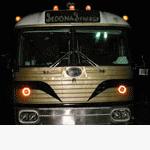 Rating: N/A |
He could reuse the AC panel main Run. The Run he would have to make is from the rear junction box to the alt. and from the AC panel to the batteries. My AC panel is in the Baggage comp right behind the condenser compartment on the ceiling. I would wonder why not just use the juice that the AC used to use from your DN alt must be over 105amp? Adding another DN will lower you MPG don't know how much someone else will know the HP that the DN takes to turn. Rob (Message edited by Robsedona on September 28, 2009) | ||
| Glenn Williams (Glenn)
Registered Member Username: Glenn Post Number: 233 Registered: 6-2006 Posted From: 216.163.57.91 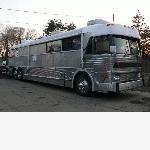 Rating: N/A |
Roger, Do you still have the original BIG Delco 50DN alternator? If so, why not just use that, then run a 0000 battery cable from the master disconnect switch in the front across the bus to the AC bay, a run of about 10 feet? A lot cheaper and easier. Then you can disconnect your house batteries from the coach while you are parked. You would also have the advantage of using them for emergency start scenarios. Good Luck! | ||
| Roger Baughman (Roger)
Registered Member Username: Roger Post Number: 131 Registered: 11-2006 Posted From: 69.232.69.224  Rating: N/A |
Nellie, I am removing the old air compressor as the syatem is TOO txpensive to keep working and it never did work well any way. I could not control the air. The air came out of just one vent and it was either too cold in which cas I had to keep turning it off and on to maintain a cool tempature. I tryed to find a way to reduce the air flow but everyone I ask about it didn't have an idea of how that could be done. Also the freon kept leaking out. Too expensive to replace all the time. I already have plans to conect the REO engine alternator to the 4000 watt inverter to run the roof airs. | ||
| Nellie Wilson (Vivianellie)
Registered Member Username: Vivianellie Post Number: 307 Registered: 11-2008 Posted From: 75.178.92.43  Rating: N/A |
Glenn & Rob- Help me out, will you? First, so I understand, what does 'DN' mean? I want to do much the same as Roger, only my batteries will have to be in a bay (to start with anyway). I'd hoped to charge them through the master disconnect, (somehow), utilizing the existing setup. Trouble is, I don't want to disconnect the house batts (usually) when I disconnect the main batts. Thanks, Nellie Wilson | ||
| Rob Norgren (Robsedona)
Registered Member Username: Robsedona Post Number: 124 Registered: 11-2007 Posted From: 75.211.140.187  Rating: N/A |
The DN is the Great Big Alternator (generator) you have on the drivers side in the back of you 8V71 (you reach past it to adjust your clutch) and if like mine driven with 4 pulleys. In my 1966 5A i have a 225amp Alt in your 5C year?? ?? The AC Heat uses close to half of the amps I use this to charge my house side going down the road. OK the switch would only disconnect your House Batteries from the Bus System not the House System And the Bus Batteries from the House System so when you are not plugged into electric you have Bus Batteries to start the Bus. | ||
| Nellie Wilson (Vivianellie)
Registered Member Username: Vivianellie Post Number: 309 Registered: 11-2008 Posted From: 75.178.92.43  Rating: N/A |
Roger: Now I get it. You meant you are putting the aux. gen (or alt.) where the the A/C comressor (not the air compressor) used to be. Right? Okay, but why do you need a 2nd Alt. if you're going to stick with 24V anyway? And what's an REO?? God, these acronyms are driving me nuts. Wish someboody would compile a list of bus acronyms and definitions. (I'd do it but I don't know what any of them mean... and I bet a lot of other folks don't either.) C'mon guys, talk English... or French if you'd rather  . Take pity on the poor novices out here. . Take pity on the poor novices out here. Nellie | ||
| clint hunter (Truthhunter)
Registered Member Username: Truthhunter Post Number: 529 Registered: 1-2009 Posted From: 24.129.232.219 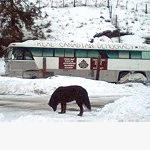 Rating: N/A |
...you have a good point there about thread quality spectrum Viveye, as this is about helping the non-mechanic comprhend and make informed choices, so a few extra key strokes is effort well spent. -Although , making it too easy to understand might encourage some to overshoot there knowledge level and lead them into a repair or modification that they should not of undertaken. ... it is rarely just 4 bolts , so cut yourself some slack girl "for not always getting it, many of use have been wrenching for many years to get to our level of understanding. As many have commented, you seem to have shown remarkable comprehension in trying to wrap your head around this bus stuff, kind of encourageing to continue the effort of sharing, on that accord alone... "ask not only what BNO forum can do for you, also what you can do for it" | ||
| Buswarrior (Buswarrior)
Registered Member Username: Buswarrior Post Number: 1715 Registered: 12-2000 Posted From: 76.71.103.43 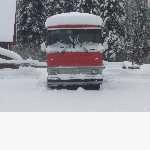 Rating: N/A |
My guess is that REO might be typo for "OEM" original equipment manufacturer or some such. The "50DN" designation is a model of Delco generator/alternator which was wildly popular for OEMs to install in coaches and transit buses. 225 amps at 24 volts, robust and re-buildable. Yes, a glossary of terms might make a good resource. happy coaching! buswarrior | ||
| john w. roan (Chessie4905)
Registered Member Username: Chessie4905 Post Number: 1661 Registered: 10-2003 Posted From: 71.58.71.157 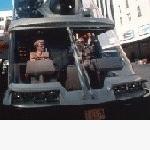 Rating: N/A |
When I was there, Nimco had 450 amp versions of that alternator that were out of city buses | ||
| doug yes (Dougg)
Registered Member Username: Dougg Post Number: 103 Registered: 1-2007 Posted From: 67.142.161.36 Rating: N/A |
Nimco 450 amps.... How many roof a/c's could you run with that, assuming the old coach A/C is out? | ||
| Buswarrior (Buswarrior)
Registered Member Username: Buswarrior Post Number: 1718 Registered: 12-2000 Posted From: 76.71.103.43  Rating: N/A |
Well, a Trace 4024 will run two roof airs with a regular 50DN, so double up? Two 4024's and 4 roof airs? And some serious sized cabling. The method of driving that 450 amp monster will have to be strong, I can hear the belts squealing from here.... happy coaching! buswarrior | ||
| Cullen Newsom (Cullennewsom)
Registered Member Username: Cullennewsom Post Number: 143 Registered: 2-2009 Posted From: 98.200.242.221 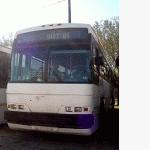 Rating: N/A |
Welding cable. Copper lugs, a punch and hammer to set them. It's cheaper than other battery cables. Also, lots of P-clips. | ||
| Nellie Wilson (Vivianellie)
Registered Member Username: Vivianellie Post Number: 312 Registered: 11-2008 Posted From: 75.178.92.43  Rating: N/A |
Indeed Bus Warrior - Glad you agree with the Bus Acronym Dictionary idea. Particulary considering a Delco Alt. producing "225 amps at 24" is called a "50DN. Gee, what kind of dummy couldn't figure that one out? I mean, olenty of clues there! Nellie | ||
| Roger Baughman (Roger)
Registered Member Username: Roger Post Number: 132 Registered: 11-2006 Posted From: 69.232.69.224  Rating: N/A |
Nellie, I plan to use the OEM orginal bus alternator, 24 volt, 225 amp, that ia already charging my two start batteries and run that power through my new 4024 inverter to run my two roof airs. The other set of batteries and the added altnator is for a back up in case something goes wrong with the OEM alternator and batteries. My wife is very heat sensitive and if she gets over heated she will get very sick real fast. I just don't want to take a chance with her health. It gets pretty hot around here in the summer. We also have two air conditioners for our house. I also have a third air on the roof of the bus, just in case. One more thing,I plan on not installing the drive belts on the back up alternator untill and if I need to use it. Nellie don't feel bad about the Acronym,s we all have to learn as we go. | ||
| FAST FRED (Fast_fred)
Registered Member Username: Fast_fred Post Number: 968 Registered: 10-2006 Posted From: 76.202.165.190  Rating: N/A |
"Welding cable. Copper lugs, a punch and hammer to set them. It's cheaper than other battery cables." Probably true but the really fine wires unprotected with a layer of tinning and the air space in a simple hammered terminal end will not have a long useful service life. With welding cable the minimum should be to flux and dunk solder the terminal end after hammering it on. For better service life a tinned starter cable with hyd attached tinned ends will last far longer. FF | ||
| Roger Baughman (Roger)
Registered Member Username: Roger Post Number: 133 Registered: 11-2006 Posted From: 69.232.69.224  Rating: N/A |
Fred,could you enlighten me as to what a tinned starter cable is? Is it the melted soder into the copper wire? And if so why is that better? And is a hyd mean hydrauclic? Thanks. | ||
| Cullen Newsom (Cullennewsom)
Registered Member Username: Cullennewsom Post Number: 145 Registered: 2-2009 Posted From: 98.200.242.221  Rating: N/A |
Roger, Tinning a wire end means melting solder into it. It keeps the strands together, and the solder is more resistant to corrosion. I guess it is called "tinning" since most solder contains tin. There is sometimes a disadvantage, which I'll discuss below. Fred, A proper crimp is of course better.
That's not been my experience. My welder's #00 welding leads have out-lasted the insulation on the wire, and lived with some harsh treatment. I've replaced every terminal end other than the lugs that bolt onto the welder. But that's due to use and abuse. It is true though, that when you mount something to a battery, acid gets on it, and it corrodes. I find that axle grease makes a good dielectric and seals against corrosion. About as good as the silicone dielectric grease which can be bought for that purpose. I never claimed my hammered-lug hack was the best, but it will last many years if done carefully. When it corrodes, take up some slack (I always install a "service loop"), trim away the corrosion, and hammer another one on. Sometimes it just isn't convenient to remove a long cable, take it to a shop, and have it done. Tinning the leads is something that I would think hard about, for the same reason you cite, and that is the fine copper strands; which are individually very weak. It is known and argued about by ing-a-neers that when you have lots of vibration, tinned leads break where the copper and tin meet. So, if you choose to tin those ends, make sure that they aren't going to vibrate. It is never a bad idea to install strain-relief. There's another good solution. Somewhere, there exists some heat-shrink tubing which has something like hot-glue inside it, when heated, the stuff shrinks down as normal heat-shrink tubing does, and the glue flows such that it makes as near to an air-tight seal as you could get in the field, yet all remains flexible. In my experience, good enough is good enough. A carefully hammered on lug will last for years. Next time I do one, I think I'll try gooping it with grease, and then putting regular old heat-shrink tubing on it. | ||
| Rob Norgren (Robsedona)
Registered Member Username: Robsedona Post Number: 126 Registered: 11-2007 Posted From: 75.209.5.128  Rating: N/A |
I did my 1st inverter about 6 years ago now with welder's #0000 (that I got from a welder his old welding wires boy the strands are supper fine in that wire) and hit it with a hammer and chisel then crimped each end with vice grips. still working and saved a lot of money. The next inverter I bought store battery cables #00 and they don't run the inverter as good I get more power to the Inverter with the welders cables. If I knew then I would have got the whole cable! About 2x50Ft Boy those woulda shoulda coulda will get ya every time LOL Rob | ||
| Roger Baughman (Roger)
Registered Member Username: Roger Post Number: 134 Registered: 11-2006 Posted From: 71.159.230.31  Rating: N/A |
Thanks guys, That info helps a lot. Roger | ||
| FAST FRED (Fast_fred)
Registered Member Username: Fast_fred Post Number: 970 Registered: 10-2006 Posted From: 76.202.165.190  Rating: N/A |
The problem is moisture can wander in and out of a crimped terminal , and those thin copper wires can easily dissolve. There are goops that will take up much of the air space that will make the connection last longer. Sealing with heat shrink tape afterwards , as well as realizing the terminal will need replacement , so extra cable is a good idea. Size counts in DC wiring , any style 0000 will do a far better job than NASA grade 00. TOO BIG is realistically not a problem.Except first cost. For most inside minor loads we simply use tinned marine 10ga for EVERYTHING , purchasing 500-1000 ft of wire at a clip can make up for some of the extra cost of better wiring. FF | ||
| john w. roan (Chessie4905)
Registered Member Username: Chessie4905 Post Number: 1664 Registered: 10-2003 Posted From: 71.58.71.157  Rating: N/A |
I know belden has heavy duty wire terminals that already have solder for them to connect to big wires. http://www.wiringproducts.com/contents/en-us/d270.html | ||
| Roger Baughman (Roger)
Registered Member Username: Roger Post Number: 136 Registered: 11-2006 Posted From: 71.159.230.31  Rating: N/A |
Thanks John, They are even cheeper than welding cable. | ||
| Glenn Williams (Glenn)
Registered Member Username: Glenn Post Number: 234 Registered: 6-2006 Posted From: 216.163.57.91  Rating: N/A |
OK Roger,your plan is for planned redundancy. I get it. Why not just wire in the spare alternator to the existing bus wiring right there at the starter? That's how I put mine in when my 50DN bit the dust. You could then still run short 0000 gauge wire through the heater compartment into the old air conditioning condenser compartment to your new battery bank. Glenn | ||
| Roger Baughman (Roger)
Registered Member Username: Roger Post Number: 139 Registered: 11-2006 Posted From: 69.232.69.224  Rating: N/A |
Thanks Glenn, I will look into that. It sounds like a great idea. | ||
| John (John_t)
Registered Member Username: John_t Post Number: 7 Registered: 10-2009 Posted From: 66.244.97.31 Rating: N/A |
Im unsure of the size of those roof airs but if they draw say 15 amps (may only be 12 amps but lets be conservative) at 120 volts, that equals 1800 watts times 2 = 3600 watts. To supply 3600 watts at 24 volts that equals 150 amps. NONE OF THIS IS TAKING INEFFICIENCY AND HEAT LOSSES INTO ACCOUNT MIND YOU. That inverter IS SURE NOT 100% EFFICIENT i.e. to put out 3600 watts it requires MORE THEN 3600 WATTS IN so lets take a guess and bump that 150 amps up to 180 (input required from 24 volts of battery) BUT ID SAY THATS PLENTY AND A CONSERVATIVE ESTIMATE. That being said and to reduce voltage drop in the cables and although IT MAY BE OVERKILL I think Id just use 4/0 copper cable. Our local Interstate Battery shop just made my buddy a 6 ft 4/0 with their machine crimpped terminals on BOTH ends for under $50 bucks, so the cost of your 72 feet WILL GET EXPENSIVE MIND YOU. PS Looks like you need a 200 amp alternator also.. Finer stranded wire like welding cable is built that way to improve flexibility (and its indeed good quality good heavy duty insulated cable), theres no skin effect problem at DC so you dont need extra fine wire actually so long as its flexible enough and has the required ampacity (like 200 amp range) I guess what Im saying is price the 4/0 cable because you may find other then "welding cable" to be more affordable, or maybe not?? SHOP AROUND John T Toooo long retired Electrical Engineer and rusty on this so NO warranty lol |